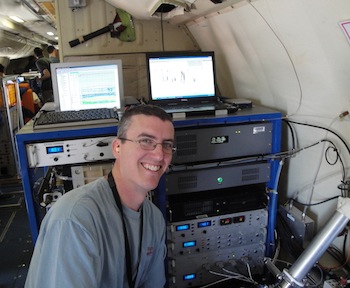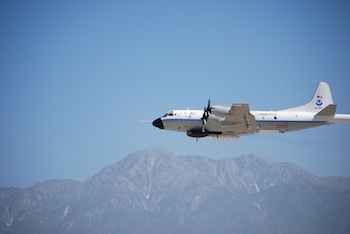2013 News & Events
Mystery solved: Extra methane in LA's air traced to fossil-fuel sources
14 May 2013

For scientists studying the sources of methane – a potent greenhouse gas – in the Los Angeles basin, things have never quite added up properly. Tallies, also known as inventories, of the amount of methane estimated to be given off by various sources (such as landfills, oil and gas pipeline leaks, dairy farms, and oil extraction and development activities) fall about 35% short of what is actually in the atmosphere.
A new study, led by ESRL CSD scientists at NOAA and its Cooperative Institute for Research in Environmental Sciences at the University of Colorado Boulder, used a novel approach to trace the methane back to its sources, and found that the extra methane is likely coming from sources related to fossil fuels. Those sources include leaks from natural gas pipelines and other oil/gas activities, as well as seepage from natural geologic sites such as the famous La Brea Tar Pits.
The research helps to resolve the discrepancy, which had been noted by several previous studies but had eluded a detailed explanation – until now.
"The key was to measure multiple chemicals in the air, because the different sources of methane have different combinations of other hydrocarbons such as propane, ethane, and butane," said Jeff Peischl, lead author and CIRES scientist working at CSD in Boulder. "The combination is like a signature or fingerprint that we could trace back and attribute to a specific type of source, such as a landfill or a pipeline."
Inventory estimates of the methane emitted from landfills and dairy farms are in line with what the scientists measured in the new study, which was published recently in the Journal of Geophysical Research: Atmospheres. But the new research finds that the methane escaping from established natural gas pipelines, oil and gas drilling activities, and geologic sources such as the tar pits, is higher than previously estimated.
Methane is the second most prevalent greenhouse gas emitted by human activities, but it is more efficient at trapping heat in the atmosphere than carbon dioxide. Pound for pound, the impact of methane is 20 times greater than carbon dioxide over a 100-year period, according to the Environmental Protection Agency.
"Our findings can help both industry and the state of California more accurately assess methane emissions," Peischl said, which would inform the state's efforts related to climate protection.

Peischl and his team gathered the data on flights of the NOAA WP-3D research aircraft (outfitted with instrumentation as a "flying chemical laboratory") and from ground stations in the Los Angeles area in the summer of 2010. Dozens of trace gases were measured during the field campaign CalNex, which was aimed at understanding the interactions of air quality and climate change issues in the region.
The novel technique is based on the fact that some sources of methane also give off other hydrocarbons. Landfills emit methane but not much else, Peischl said. But local oil and gas activities emit ethane, propane, butane, and pentane in small but accurately measurable amounts, along with the methane. The natural gas in urban pipelines has yet another distinct signature, consisting of mostly methane and some ethane and propane, but no butane and pentane.
"The clues are in the chemistry," said Peischl, "and we could use our data to put a number on the amount of methane emitted by the different sources. When we added everything up, we found that the sources related to fossil fuels were emitting more methane than accounted for in the inventories."
So how do the various methane sources add up in the LA basin, according to the new study? The scientists found that landfills, dairies, and wastewater treatment facilities emit about 40% of the total amount of methane emissions in the LA basin. A similar amount comes from a combination of leaks from existing pipelines and seeps from geologic sources—a human source and a natural source that each consist primarily of methane with small amounts of ethane and propane and cannot be distinguished using the method of the study. The bulk of the remainder of the methane in Los Angeles (about 8%) is due to leaks from exploration and extraction activities of the local oil and gas industry. This number represents about 17% of the natural gas produced in the region, similar to the leak rate estimated by the California Air Resources Board using other methods.
Would the scientists find these same sources of methane, and be able to resolve discrepancies, in other parts of the U.S.?
"We won't know until we go there," Peischl said. "But our technique now gives us a way to determine the sources of the methane in the atmosphere, whether from ground-based measurements or from aircraft."
Coauthors of "Quantifying sources of methane using light alkanes in the Los Angeles basin, California" are from CIRES, NOAA Earth System Research Laboratory, University of Miami, University of California, and Harvard University.
Peischl, J., T. B. Ryerson, J. Brioude, K. C. Aikin, A. E. Andrews, E. Atlas, D. Blake, B. C. Daube, J. A. de Gouw, E. Dlugokencky, G. J. Frost, D. R. Gentner, J. B. Gilman, A. H. Goldstein, R. A. Harley, J. S. Holloway, J. Kofler, W. C. Kuster, P. M. Lang, P. C. Novelli, G. W. Santoni, M. Trainer, S. C. Wofsy, D. D. Parrish, Quantifying sources of methane using light alkanes in the Los Angeles basin, California, Journal of Geophysical Research, doi:10.1002/jgrd.50413, 2013.
Abstract
Methane (CH4), carbon dioxide (CO2), carbon monoxide (CO), and C2-C5 alkanes were measured throughout the Los Angeles (L.A.) basin in May and June 2010. We use these data to show that the emission ratios of CH4/CO and CH4/CO2 in the L.A. basin are larger than expected from population-apportioned bottom-up state inventories, consistent with previously published work. We use experimentally determined CH4/CO and CH4/CO2 emission ratios in combination with annual State of California CO and CO2 inventories to derive a yearly emission rate of CH4 to the L.A. basin. We further use the airborne measurements to directly derive CH4 emission rates from dairy operations in Chino, and from the two largest landfills in the L.A. basin, and show these sources are accurately represented in the California Air Resources Board greenhouse gas inventory for CH4. We then use measurements of C2-C5 alkanes to quantify the relative contribution of other CH4 sources in the L.A. basin, with results differing from those of previous studies. The atmospheric data are consistent with the majority of CH4 emissions in the region coming from fugitive losses from natural gas in pipelines and urban distribution systems and/or geologic seeps, as well as landfills and dairies. The local oil and gas industry also provides a significant source of CH4 in the area. The addition of CH4 emissions from natural gas pipelines and urban distribution systems and/or geologic seeps and from the local oil and gas industry is sufficient to account for the differences between the top-down and bottom-up CH4 inventories identified in previously published work.